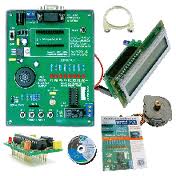The Basic Stamp Microcontroller
The Basic Stamp Microcontroller is one of the original microcontrollers for the hobbyist.

The BASIC Stamp microcontroller serves as the brains inside electronics projects and applications that require a programmable microcontroller. It’s basically called a “stamp” because its size is close to that of an average postage stamp, except for the BS2p40 version, which is much longer due to additional I/O pins. There are currently eight functional versions and thirteen physical versions.
This microcontroller is a single-board computer that runs the Parallax PBASIC language interpreter in its microcontroller. The PBASIC is an easy-to-learn language that allows users to produce many powerful commands, turning complex tasks such as pulse width modulation, serial communication and button debounce into simple, easy-to-execute instructions.
The developer's code is stored in an EEPROM, which can also be used for data storage. The PBASIC language has easy-to-use commands for basic I/O (input/output), like turning devices on or off, interfacing with sensors, etc. The more advanced commands let the BS module interface with other integrated circuits, communicate with each other, and operate in networks.
This microcontroller can execute between 2,000 and 19,000 instructions per second, depending on model. It is able to control and monitor timers, keypads, motors, sensors, switches, relays, lights, and more. It draws a mere 3 mA of current while running, and in sleep mode requires only 50 ìA. All general purpose I/O lines on Stamp modules can be set as either inputs or outputs, and can be switched at run time.
This line of microcontrollers was created specifically to make learning to use a ì-controller simple and easy, which is perfect for beginners. The Stamp microcontroller can act as stand-alone ICs (integrated circuit), which users can plug into a board and immediately begin programming, requiring no other circuitry. All vital components (processor, clock source, memory, power regulator) are provided on the BS2's tiny PCB, so all one needs to do is to simply connect the power.
Projects needing small, permanent soldering area for circuitry may benefit from combining the BS2-IC with other BS2 components such as the Carrier Board or the Super Carrier Board.
There is also an enormous amount of information for Stamps available in print and online, which makes the Stamp line of microcontrollers one of the most widely documented ì-controllers in existence. Because it is so easy to use, high schools and universities usually make use of the Stamp IC for their robotics programs.
It is also a fixture in hobby and industrial applications. For more advanced projects that require multi-processing or video generation capabilities, Parallax also offers the Propeller microcontroller. These, along with several experiment-based tutorials for robotics beginners and enthusiasts alike are available online. Their starter kits include the BASIC Stamp 2; the BASIC Stamp Activity Kit and the BASIC Stamp Discovery Kit.
Here are the specific features of the BS2 microcontroller
- Processor Speed: 20 MHz
- Program Execution Speed: ~4,000 PBASIC instructions/sec.
- RAM Size: 32 Bytes (6 I/0, 26 Variable)
- EEPROM (Program) Size: 2 KBytes; ~500 PBASIC instructions
- Number of I/O Pins: 16 + 2 dedicated serial
- Current Draw @ 5 VDC: 3mA Run, 50 ìA
- Sleep Source/Sink Current per I/O: 20 mA / 25 mA
- Source/Sink Current per unit: 40 mA / 50 mA per 8 I/O pins
- PBASIC Commands: 42
- Package: 24-pin DIP Industrial-Rated since Rev J
Key specifications
- Power Requirements: 5.5 to 15 VDC (Vin), or 5 VDC (Vdd) Communication: Serial (9600 baud for programming)
- Dimensions: 1.20 x 0.63 x 0.15 in (30.0 x 16.0 x 3.81 mm)
- Operating Temperature: -40 to +185 °F (-40 to +85 °C)
- Price Range: $50 - $100, online.